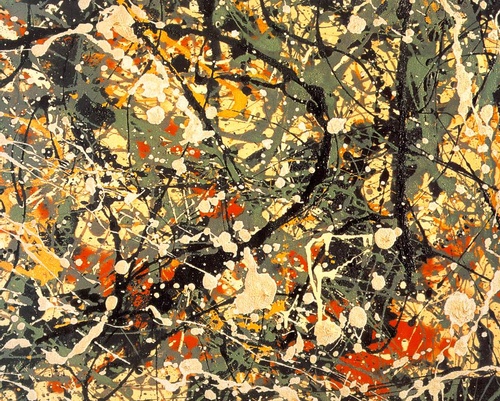
Stupid for Art
So you’re at a gallery—now what?
Jackson Pollock, Number 8, 1949.
There are a lot of stupid reasons to go to an art gallery, all of which are fun and satisfying for the first five minutes. These reasons mainly involve pretending that you are smart, that you are elevated, passionate, sensitive—in short, lying about yourself. There is nothing wrong with a little self-glory, and I wouldn’t deny anyone a pleasure I personally find so rewarding. But pretending to be smart is less fun if it means paying twenty dollars to stand around for two hours, wishing for a chair. Sometimes, pretending to be smart is actually pretty stupid.
Walking into a room full of art puts you in a vulnerable situation. We all know the blurry, church-like feeling of wandering listlessly through an exhibition, slowly remembering how much you don’t care. It’s hard not to treat it like a performance. But what are you supposed to do instead? I often find myself wanting to respond to art using my tongue, or the soft skin of my wrists, or a Sharpie or a hammer. But none of that is acceptable. Even napping is unacceptable at an art gallery. Eventually, you just walk away.
For most activities with ambiguous returns—such as travelling the world or going to a bar—you can use your camera as a pacifier. If nothing else, you get a picture. But picture-taking at a gallery is considered crass. So, instead of photo ops, the curators offer explanatory labels next to the art, conveniently bagging the experience so you can take it home and stuff it under the sink. You’d think the real reason people make art is to answer that punishing grade-school query: “What is it?”
The fact is, nobody knows what art is or why people make it. This is blatantly disturbing. Some say the function of art is to generate conversation—an unpleasant thought. I’m not sure we want to put art in the same category as skin disease and Carl Winslow: things to talk about on the internet.
This is why so many of us have a bad time at galleries: we try to make art Interesting when we should just let it be weird. Art should never be Interesting. Wikipedia is Interesting. Nightmares are Interesting. But to feign Interest in other people’s art is just smug. Don’t be so fond and fatherly about it. If you’re going to take a familial stance toward art, you can’t do better than the little brother, approaching the gallery with the mindset of an awestruck ankle-biter.
The real reason to go to an art gallery is to witness a small number of people elaborate publicly on their own confused striving, beyond explanation or accountability or compromise. You don’t see that just anywhere. In a gallery, one finds all the raw elements of fear and desire, the most dim and keening shapes, smiling strangely from the backyards of awareness and submitted painfully for general inspection. This is not what you might find at, say, Boston Pizza.
The white walls of the gallery are designed to be dramatic, like meeting God in the movies. The message is: “Nothing else exists but this moment of beholding.” Context be damned! The only way to rescue art from the miasma of higher learning is to go all the way, to let the gallery be as theatrical as the architecture suggests. Pull up a folding chair. You’re in heaven.
Of course, drama is always a little embarrassing, but it’s not worth going anywhere if you don’t have to swim a river of shame to get there. Otherwise, you’re left to convince yourself that boredom is the only intelligent option. Instead, pretend that landscape paintings are actual photographs of magical worlds. Whatever you may think about the possibility of escaping place and history, there’s no denying that it’s fun to try.
The main goal of being stupid about art, obviously, is to learn as little as possible about what you are looking at. If you start to learn things, you may accidentally trick yourself into thinking that learning things is why you are there, as if learning is some special hobby of yours. Rather, ask yourself such questions as, “Could this get any more red?” or, “Why do people like this?”
Refrain from reading any wall panels that may appear near the artwork. Brochures, pamphlets and funny-shaped portable audio devices should also be avoided, as should people leading tours or anyone trying to make eye contact. Ignore the name of the artist and the year the piece was made; treat every artwork as if someone you once stared at on the subway made it in her fantastic basement studio last week.
As you look at a piece of art, try to think of the artist as a friend, one who mails you covert recordings of her other friends, or who watches a movie you like in her private time just because you mentioned it once. Now you’ve come to a party and she keeps passing you disconcertingly lurid notes. Maybe it wouldn’t happen like that in real life, but reality isn’t our concern here. Reality has trees and underpasses; a gallery is full of people chasing trails.
When art arrives before you from nowhere and nobody, it starts to look like what it is: something strange, something new. People have made art for half a million stupid reasons, but mostly because nothing that existed before was good enough. Good enough for what? That’s what we’re all trying to figure out.





